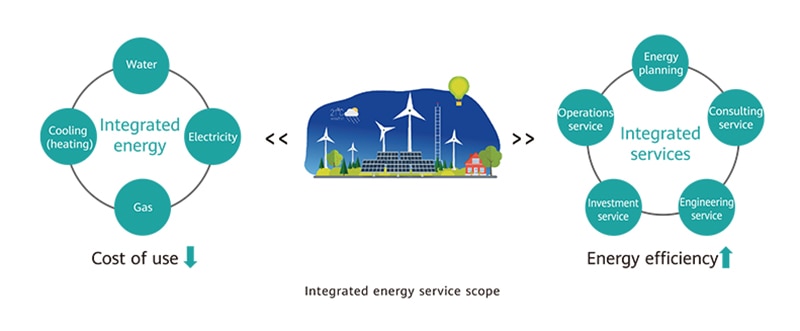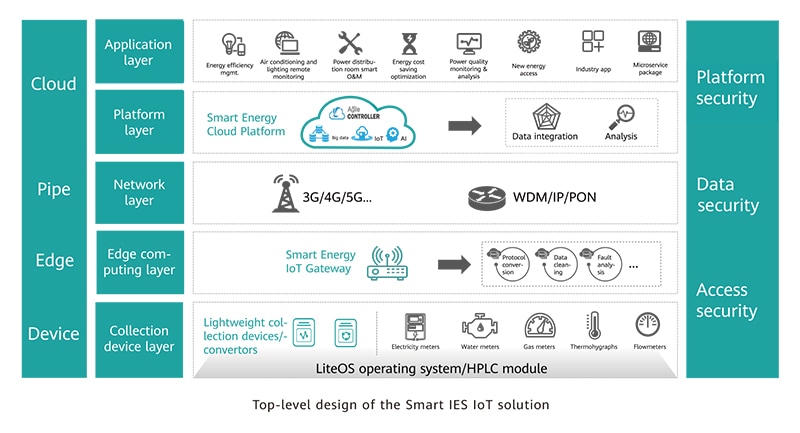Building smart energy services with IoT
Building smart energy services with IoT
Chinese power grid companies have been transforming from traditional electricity suppliers into integrated energy service providers in response to the opportunities and challenges brought about by the green energy revolution.

State Grid Hunan Integrated Energy Services (IES) and Huawei have developed a Smart IES IoT solution based on cloud-edge-device IoT architecture, aiming to tackle common problems in developing integrated energy services. These problems include a lack of basic data and platforms, difficult O&M management, software and hardware coupling, multiple access scenarios, and on-site deployment difficulties.
The Smart IES IoT solution comprising apps, a breakthrough IoT gateway with smart edge computing capabilities, and a multi-container technology that decouples software and hardware. It support flexible service expansion, open data-sharing, and smart cloud-edge collaboration, and provides an intelligent, open, and efficient digital platform for integrated energy services, powered by big data, AI components, and microservice architecture.
Hunan's Better Life Group adopted the solution to transform over 100 of its stores to provide refined energy management, real-time energy consumption management and control, and intelligent air conditioning and lighting management. This has helped Better Life save more than 20 percent in energy, boost corporate management, and meet its green targets.
Green energy revolution
With fossil fuels becoming scarcer, pollution increasing, and climate change becoming more severe, the efficient use of green energy and renewable energy is essential for society to progress. As a green, clean energy type that's high-quality, efficient, and renewable, electric power can meet most energy needs.
China is committed to creating a global energy Internet and promoting clean and green ways to meet global electricity demand, pledging to accelerate reform for building an energy sector that’s clean, low-carbon, safe, and efficient.
Power grids, transmission, and distribution will remain under central control, with free market forces allowed to act on power generation and consumption. This will establish a more complete, fully competitive, and effective energy market, and facilitate efficient energy use and healthy development.
Grid companies are targeting new opportunities in the IES market. State Grid Hunan IES set up an integrated energy service subsidiary to transform from a traditional electricity supplier into an IES provider, and established new service types to help satisfy diverse energy demands, boost user stickiness, and increase income from value-added income.
Main obstacles to IES
Integrated energy services can meet diverse energy production and consumption needs, including energy planning and design, engineering construction and investment, multi-energy operations and services, and investment and financing services.
State Grid Hunan IES develops personalized services for energy-intensive customers for whom air conditioning makes up a large proportion of electricity consumption, such as commercial buildings, industrial enterprises, and large campuses.
On the supply side, it established an electricity-based multi-energy power supply system that helps customers reduce energy costs, including distributed power generation, tri-generation (combined heating, cooling, and power), and energy storage.

On the energy side, it developed an electricity-centric device energy consumption system to help customers improve energy efficiency. The solution provides energy-saving services, energy O&M, and energy consumption monitoring and analysis. It promotes energy and information integration and makes full use of technological, resource-, and funding-based approaches.
When State Grid Hunan IES first launched integrated energy services, the main issues it faced were the lack of detailed energy consumption data and a basic digital platform for support service development.
Energy customers don't usually have detailed data about energy use, like energy by category and item, consumption time and spatial distribution, overview and indicators, or abnormal energy consumption warnings. That means there’s no data to analyze energy use, no way to manage energy, and no way to verify energy efficiency transformation.
When State Grid Hunan IES first launched, it lacked an intelligent digital platform for the remote management of equipment and software upgrades or energy data analysis to support mass data analysis and flexible applications, which severely restricted how fast it could develop its services.
Smart IES IoT
State Grid Hunan IES teamed up with Huawei to develop an innovative Smart IES IoT solution based on the cloud-pipe-edge-device core architecture that would allow them to build an integrated energy service digital platform to support data perception, edge processing, and smart applications; meet the IoT application requirements of integrated energy services in multiple scenarios; and support the development of such services.
- Cloud: Visualized remote management
At the cloud layer, we adopt a cloud management architecture comprising an application layer and a platform layer.
The application layer provides an open northbound interface for industry integrators to build app service packages and provide professional services for energy customers. This leverages industry vendors' deep understanding of the industry and the technology of the application scenarios.
The platform layer provides the IoT platform, a big data component, and an AI component. It supports remote visual management of the full lifecycle of millions of end devices, real-time monitoring of whole-network status, rapid fault location, and the analysis and processing of mass energy consumption data. It incorporates the latest industry policy changes, identifies high-value data, and discovers energy customers' requirements.

- Edge: Edge-cloud collaboration is more efficient
At the edge computing layer, we use edge computing technology to redefine the energy gateway device and give it a smart brain. The Smart IES IoT Gateway acts like a smartphone – functions can be customized or added on-demand and it can flexibly share data so it can link to different service ecosystems. This creates a multi-functional device and avoids redundant development of other hardware systems.
Cloud-edge collaboration is also used to support hierarchical data analysis and processing for efficient applications. The cloud and edge collaborate efficiently – with the cloud mainly handling big data analysis of energy consumption, human-computer interaction, and strategy generation, while the edge mostly deals with data pre-processing and strategy decomposition and execution.
- Device: Full electric, water, gas, and heating/cooling data collection
At the data collection device layer, we use lightweight data collection devices and lightweight converters that adopt industrial-grade high-speed power-line communication (HPLC). That means devices can network over power lines; have plug-and-play capability; and use ordinary power lines to collect energy consumption data economically, reliably, and efficiently. They also support multiple-wired/wireless-interface conversion, which fully meets the service access needs of scenarios like electricity, water, gas, heating/cooling and provides basic data for integrated energy services.
Refined energy management
In 2020, the energy consumption of one company, which has partnered with State Grid Hunan IES, was projected to rise to over 500 million kWh. With energy costs increasing every year, the company’s major priority was to improve energy efficiency. By conserving energy and reducing energy consumption, it could strengthen its competitiveness and ability to survive.
A lack of data for energy efficiency transformation and manual energy management were general issues at the company's stores. Energy consumption data was collected through manual meter reading, which is inefficient and error-prone. There were also no detailed data measurements by item such as air-conditioning, lighting, and freezers. Moreover, energy consumption data from individual stores was siloed, making it impossible to generate cross-comparison data.
State Grid Hunan IES and the company signed a strategic agreement for integrated energy services, building a three-level energy management and control platform that adopted Huawei's Smart IES IoT solution. The platform can collect data from over 50 different types of appliances, including air conditioners, elevators, sewage pumps, large advertising screens, and quantitative lighting.
It also provides a package of sub-services. These include energy efficiency transformation and operation monitoring for devices, line status early warnings, abnormal operation warnings, load forecasts, energy consumption rational analysis, use management for lighting and other appliances, energy efficiency improvement recommendations, and the construction of charging piles for parking lots. Thanks to these functions, the platform has helped the company implement refined energy management, implement "last-mile" energy management, and build an integrated energy service management and control platform. Services like energy-saving, power O&M, and energy consumption monitoring and analysis, have helped the company improve energy efficiency, reduce energy costs, eliminate potential energy safety hazards, ensure green and safe operations, and improve corporate management.
State Grid Hunan IES will continue to work with Huawei to create leading energy solutions based on 5G, AI, cloud and other innovative ICT capabilities to better serve energy customers. Huawei's Smart Integrated Energy Service IoT solution digitally manages vast amounts of energy assets, realizing efficient device-to-device, device-to-people, and people-to-nature synergy, helping partners establish integrated energy services for a better future.



Comments
Post a Comment